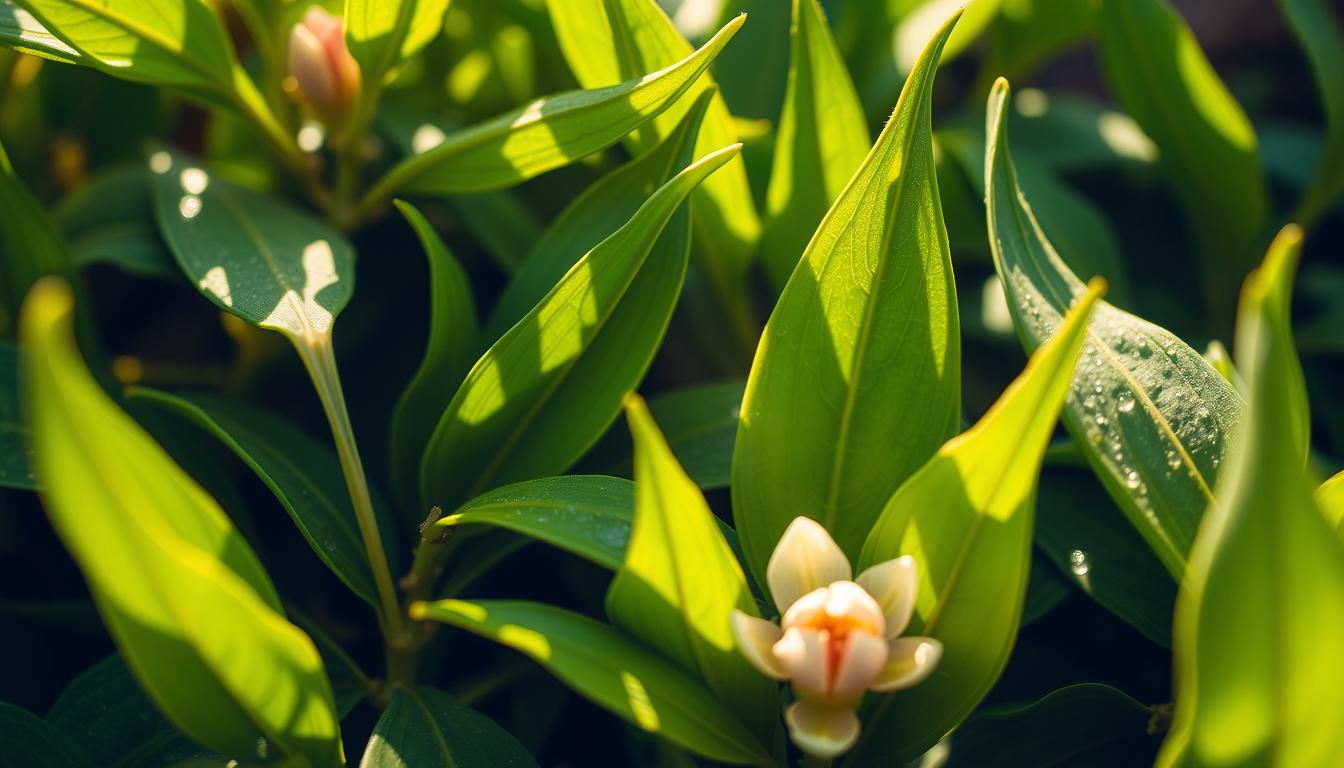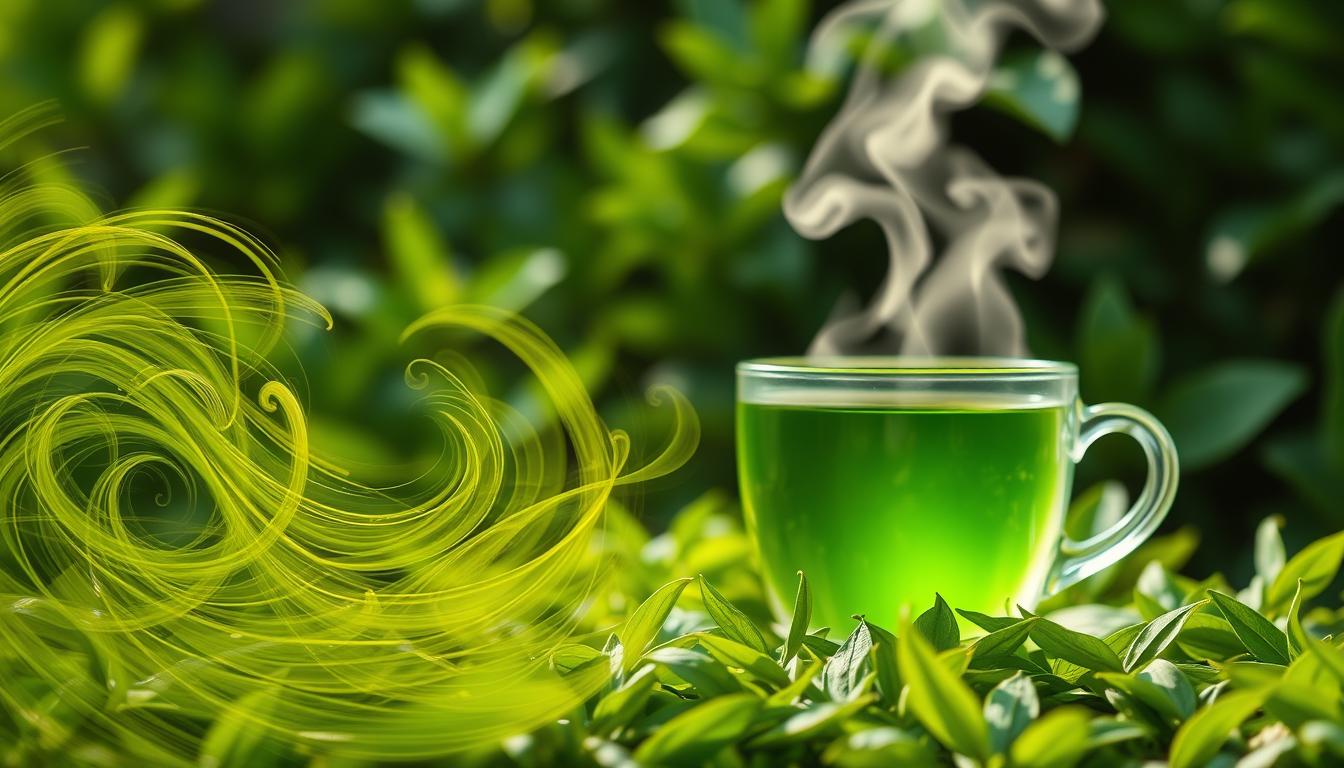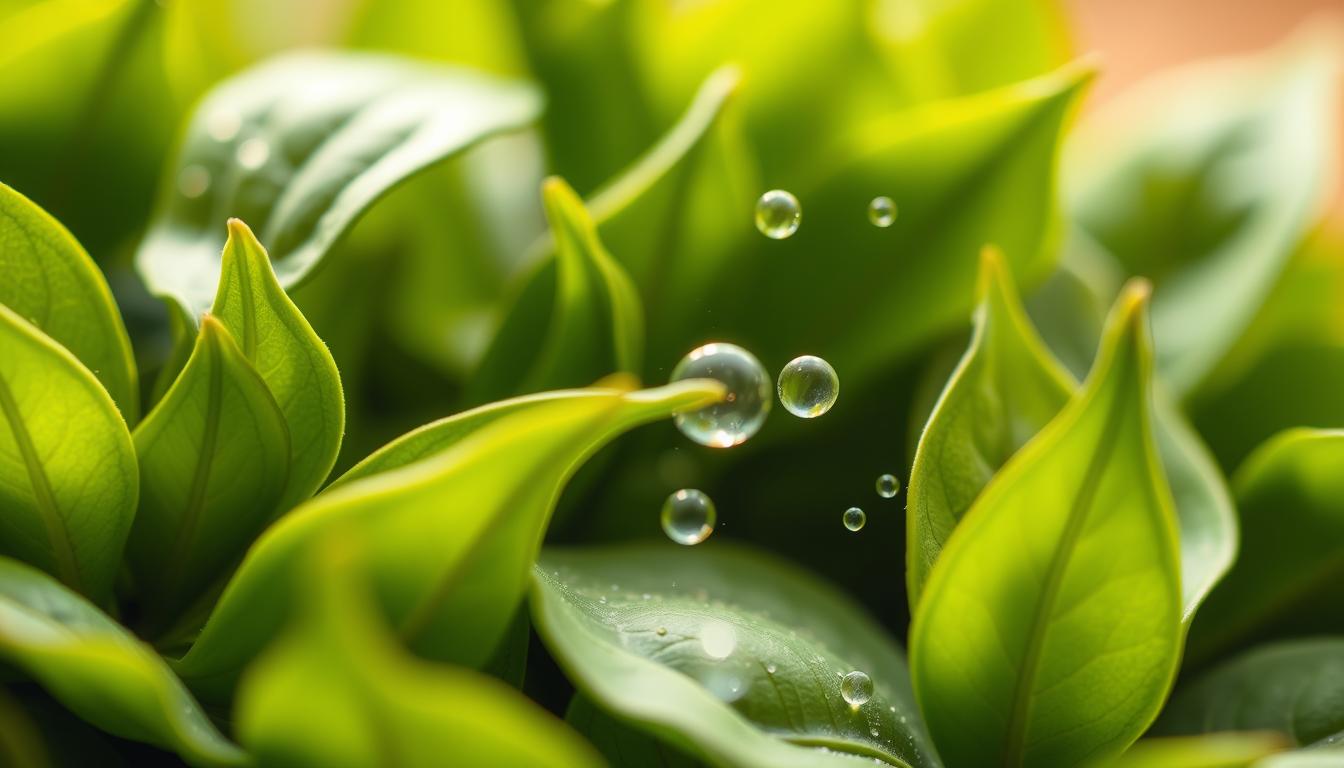Did you know that a single cup of this popular beverage contains less caffeine than coffee? Many people turn to this drink for its refreshing taste and potential health benefits. But how much of a stimulant does it really have?
Green tea is known for its natural properties and mild effects. Compared to black tea or coffee, its caffeine content is significantly lower. An 8-ounce serving typically ranges between 30-50 mg. This makes it a gentler option for those sensitive to stimulants.
This beverage has been enjoyed for centuries, valued for its calming yet energizing qualities. Whether you’re looking to reduce your caffeine intake or explore its health benefits, understanding its components is key. Let’s dive deeper into what makes this drink so unique.
Key Takeaways
- Green tea contains a modest amount of caffeine.
- Its caffeine content is lower than coffee and black tea.
- An 8-ounce cup averages 30-50 mg of caffeine.
- It’s a popular choice for its health benefits.
- Understanding its components can help you make informed choices.
Understanding Green Tea and Its Components
Green tea’s journey began over 4,000 years ago in ancient China. Legend has it that Emperor Shen Nong discovered it in 2737 B.C. when tea leaves accidentally fell into his boiling water. Since then, this beverage has become a global favorite, celebrated for its refreshing taste and health benefits.

What sets green tea apart is its minimal processing. Unlike black tea, which undergoes full oxidation, green tea leaves are steamed or pan-fired. This process helps retain its natural nutrients, making it one of the healthiest types of tea available.
Overview of Green Tea’s History and Origins
Green tea’s origins are deeply rooted in Chinese culture. It was initially used for medicinal purposes before becoming a daily drink. Over centuries, its popularity spread to Japan, where it became an integral part of traditional ceremonies.
Today, green tea is enjoyed worldwide, not just for its flavor but also for its potential health benefits. Its rich history and cultural significance make it more than just a beverage—it’s a symbol of wellness and tradition.
Antioxidants and Polyphenols Explained
Green tea contains powerful bioactive compounds, including antioxidants and polyphenols. These substances help protect the body from damage caused by free radicals. One of the most studied polyphenols in green tea is epigallocatechin gallate (EGCG), known for its potential health benefits.
Research suggests that EGCG may support brain function, promote heart health, and even reduce the risk of certain diseases. Its antioxidant properties also play a role in maintaining overall wellness.
Compared to black tea, green tea retains higher levels of these beneficial compounds due to its minimal processing. This makes it a superior choice for those seeking to maximize their nutrient intake.
Exploring the Health Benefits of Green Tea
Research shows that this beverage offers more than just a refreshing sip—it’s packed with health advantages. From supporting weight management to promoting heart health, the benefits of this drink are backed by science. Let’s explore how it can enhance your well-being.

Potential Weight Loss and Metabolic Effects
One of the most talked-about benefits is its role in weight management. Studies suggest that the catechins in this beverage, combined with a small amount of caffeine, can boost metabolism. This synergy helps the body burn fat more efficiently.
A 2020 meta-analysis found that regular consumption of this drink may lead to a modest reduction in body weight. Participants who included it in their daily routine saw improvements in their metabolic rate. This makes it a great addition to a healthy lifestyle.
Cardiovascular and Anti-inflammatory Advantages
This beverage is also known for its heart-healthy properties. Research indicates that its antioxidants can help lower bad cholesterol levels and reduce blood pressure. These effects contribute to a lower risk of heart disease.
Additionally, its anti-inflammatory properties may reduce the risk of chronic conditions like cancer. A 2021 study highlighted that regular drinkers had a lower incidence of inflammation-related diseases. This makes it a powerful ally for long-term health.
| Benefit | Key Findings |
|---|---|
| Weight Management | Boosts metabolism and aids fat burning |
| Heart Health | Lowers cholesterol and blood pressure |
| Anti-inflammatory | Reduces risk of chronic diseases |
Incorporating this drink into your routine can offer a range of health benefits. Whether you’re looking to manage your weight or support your heart, it’s a simple yet effective choice.
does green tea have caffeine? Breaking Down the Caffeine Content
Understanding the caffeine content in green tea can help you make better beverage choices. While it’s known for its mild stimulant effect, the amount of caffeine in this drink is significantly lower than in coffee or black tea. Let’s explore the details.
An 8-ounce cup of green tea typically contains 30-50 mg of caffeine. This is much less than coffee, which averages 80-100 mg per cup, or black tea, which can range higher. The difference lies in the processing and brewing methods.
Natural Caffeine in Green Tea Compared to Other Brews
Green tea’s caffeine content is influenced by factors like water temperature and steeping time. Brewing with cooler water or shorter steeping times can reduce the caffeine extracted. This makes it a versatile option for those who want to control their intake.
Compared to coffee, green tea offers a gentler stimulant effect. This is partly due to the presence of L-theanine, an amino acid that promotes relaxation without drowsiness. Together, these components create a balanced experience.
| Beverage | Average Caffeine Content (8 oz) |
|---|---|
| Green Tea | 30-50 mg |
| Black Tea | 40-70 mg |
| Coffee | 80-100 mg |
According to the FDA, moderate caffeine consumption is generally safe for most adults. Green tea’s lower caffeine levels make it a suitable choice for those sensitive to stimulants. Its natural properties also provide additional health benefits.
Whether you’re looking for a mild energy boost or a calming drink, green tea offers a balanced option. Its caffeine content, combined with L-theanine, ensures a smooth and enjoyable experience.
Factors That Influence Caffeine Levels in Green Tea
The caffeine content in green tea can vary widely depending on several factors. From brewing techniques to the quality of the leaves, each element plays a role in determining the final amount. Understanding these factors can help you tailor your tea preparation to suit your preferences.
Brewing Methods, Water Temperature, and Steeping Time
How you brew your tea significantly impacts its caffeine content. Hotter water and longer steeping times extract more caffeine from the leaves. For example, steeping for 5 minutes in water at 185°F will yield a stronger cup compared to a 2-minute steep at 160°F.
Bagged teas often have higher caffeine extraction due to the crushed leaves. Loose-leaf varieties, on the other hand, allow for more control over the strength. Adjusting these parameters can help you achieve your desired caffeine level.
Leaf Quality, Harvest Season, and Processing Techniques
The quality of the leaves and when they are harvested also affect caffeine levels. Younger leaves, typically picked in the spring, contain more caffeine than older leaves. The processing method, such as steaming or pan-firing, can influence the retention of natural compounds.
Studies show that minimal processing helps retain higher levels of polyphenols, which can enhance the health benefits of the tea. Understanding these factors allows you to choose the best type for your needs.
| Factor | Impact on Caffeine Content |
|---|---|
| Water Temperature | Higher temperatures increase caffeine extraction |
| Steeping Time | Longer steeping times yield stronger tea |
| Leaf Quality | Younger leaves have higher caffeine levels |
| Harvest Season | Spring harvests are richer in caffeine |
| Processing Technique | Minimal processing retains more natural compounds |
By paying attention to these factors, you can optimize your tea preparation for both flavor and caffeine content. Whether you prefer a mild or strong cup, understanding these elements ensures a satisfying experience.
Green Tea Versus Other Caffeinated Beverages
When choosing a caffeinated drink, it’s helpful to compare the options available. Green tea, coffee, black tea, and matcha all offer unique benefits and varying levels of caffeine. Understanding these differences can help you select the best beverage for your needs.
Comparing Caffeine Content: Coffee, Black Tea, and Matcha
Green tea contains about 30-50 mg of caffeine per 8-ounce cup. This is significantly lower than coffee, which averages 80-100 mg, and black tea, which ranges from 40-70 mg. Matcha, a powdered form of green tea, has a higher caffeine content, often around 70 mg per serving.
| Beverage | Caffeine Content (8 oz) |
|---|---|
| Green Tea | 30-50 mg |
| Black Tea | 40-70 mg |
| Coffee | 80-100 mg |
| Matcha | ~70 mg |
These differences are influenced by factors like brewing methods and the type of leaves used. For example, matcha’s higher caffeine is due to consuming the whole leaf in powdered form.
Advantages of L-Theanine’s Synergistic Effects
Green tea stands out because of L-theanine, an amino acid that promotes relaxation without drowsiness. When combined with caffeine, it creates a balanced effect, improving focus and reducing anxiety. This synergy is unique to green tea and not found in coffee or black tea.
Studies show that L-theanine enhances brain function by increasing alpha wave activity. This leads to a calm yet alert state, making green tea an excellent choice for those seeking mental clarity without the jitters.
By understanding these comparisons, you can choose a beverage that aligns with your lifestyle and health goals. Whether you prefer a mild stimulant or a stronger boost, green tea offers a versatile and beneficial option.
Potential Side Effects and Considerations
While green tea offers numerous benefits, it’s important to be aware of potential side effects. Overconsumption or sensitivity to its components can lead to certain risks. Understanding these factors helps you enjoy this beverage safely and responsibly.
Caffeine Sensitivity, Insomnia, and Other Risks
Green tea contains caffeine, which can affect individuals differently. For some, even a small amount may cause jitteriness, anxiety, or sleep disturbances. Those sensitive to stimulants should monitor their intake to avoid these issues.
Insomnia is a common concern for those who consume caffeine late in the day. To prevent sleep disruptions, consider drinking green tea earlier in the morning or opting for decaffeinated versions. Moderation is key to balancing its benefits and risks.
Other potential side effects include stomach upset or headaches in rare cases. If you experience these symptoms, reducing your consumption or consulting a healthcare provider may help.
Interactions with Medications and Overall Consumption Guidelines
Green tea may interact with certain medications, such as blood thinners or drugs for heart conditions. Its compounds can affect how these medications work, potentially increasing health risks. Always consult your doctor if you’re on medication.
For most adults, drinking up to eight cups daily is considered safe. However, individual tolerance varies. Pregnant women, those with specific health conditions, or individuals taking medications should limit their intake or seek medical advice.
Here are some practical tips to enjoy green tea responsibly:
- Monitor your caffeine sensitivity and adjust your intake accordingly.
- Avoid drinking it late in the day to prevent insomnia.
- Consult a healthcare provider if you’re on medication.
- Stick to moderate consumption levels for optimal benefits.
By being mindful of these considerations, you can enjoy green tea’s advantages while minimizing potential risks. A balanced approach ensures it remains a healthy part of your routine.
Tips for Enjoying Green Tea Safely
Incorporating green tea into your daily routine can be both enjoyable and beneficial. To make the most of its advantages, it’s important to follow a few simple guidelines. These tips will help you enjoy this drink responsibly while maximizing its potential.
Establishing a Healthy Daily Routine
Start your day with a cup of green tea to take advantage of its gentle caffeine boost. This can help you feel alert and focused without the jitters often associated with coffee. Pairing it with a balanced breakfast sets a positive tone for the day.
For those who enjoy multiple cups, spacing them throughout the day is a good practice. This ensures a steady energy level without overloading your system. Remember, moderation is key to reaping the benefits.
Moderate Consumption and Timing Practices
To avoid sleep disruptions, it’s best to avoid drinking green tea late in the day. Its caffeine content, though mild, can still affect those sensitive to stimulants. If you’re prone to insomnia, consider switching to decaffeinated versions in the evening.
Experiment with brewing methods to find the perfect balance of flavor and caffeine. Using cooler water or shorter steeping times can reduce the caffeine extracted, making it a customizable option for your needs.
Here are some additional tips to enjoy green tea safely:
- Limit your intake to 3-4 cups daily for optimal benefits.
- Pair it with a balanced diet and regular physical activity.
- Listen to your body and adjust your consumption as needed.
By following these practices, you can make green tea a healthy and enjoyable part of your lifestyle. Its versatility and health benefits make it a drink worth savoring.
Conclusion
Green tea has been cherished for centuries, offering a unique blend of flavor and wellness. Its moderate caffeine content, typically 30-50 mg per cup, makes it a healthier alternative to stronger stimulants like coffee. This beverage is not only refreshing but also packed with antioxidants and polyphenols that support overall health.
From boosting metabolism to promoting heart health, the benefits of green tea are well-documented. Its calming yet energizing effects, thanks to the presence of L-theanine, make it a favorite for those seeking balance. Whether you’re looking to improve focus or reduce inflammation, this drink has something to offer.
When incorporating green tea into your routine, moderation is key. Be mindful of your caffeine sensitivity and avoid late-day consumption to prevent sleep disruptions. By enjoying it responsibly, you can unlock its full potential as a natural, healthful beverage.
In conclusion, green tea is more than just a drink—it’s a lifestyle choice that combines tradition, taste, and wellness. Embrace its benefits and make it a part of your daily journey toward better health.

